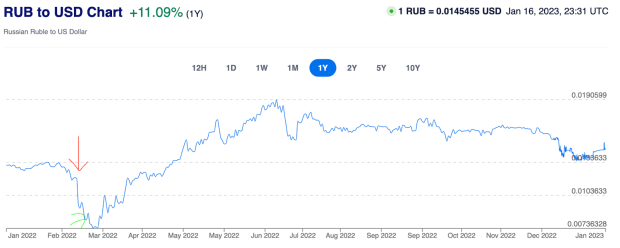With their newly-announced stablecoin experiment doomed to fail, Russia and Iran will soon learn Bitcoin is the solution that they want.
This is an opinion editorial by Q Ghaemi, a stocks and bitcoin analyst and author of the Qweekly Update newsletter.
Earlier this month, reports surfaced that the Central Bank of Iran is working with the Russian Association Of The Crypto Industry And Blockchain to create a stablecoin that will be backed by gold to settle trade. This is not the first foray into the crypto universe for either country, nor will it be the last. But this venture will come to nothing, ultimately bringing both countries one step closer to adopting Bitcoin.
Iran’s Foray Into Cryptocurrencies Favor Bitcoin
In August 2022, a headline came and went and most did not hear about it, and those who did gave it little thought: “Iran Approves Use Of Cryptocurrency For Imports To Bust Sanctions.” Ignoring the fact that the source for this headline was a Saudi-funded media outlet with the likely goal of destabilizing and delegitimizing Iran, it is important to recognize that Iran successfully completed a trade in August with an estimated value of $10 million, which can be assumed to have been conducted in bitcoin.
Based on daily volume, there are about 20 possible cryptocurrencies that could have been used to complete this transaction, however, if we take these cryptocurrencies by daily volume and agree that none with a daily volume less than $1 billion could have possibly been used (anything greater than 1% of daily volume would move the price too significantly: 1% of $1 billion is $10 million) we are left with seven possible cryptocurrencies: Ripple (XRP), Solana (SOL), USDC, Ethereum (ETH), Binance (BNB), Tether (USDT) and Bitcoin (BTC).
We can quickly eliminate USDC, Solana and Ripple because they are all run by U.S. corporations and, due to sanction laws (see: Tornado Cash), they would be forced to prevent Iran from using their platform (also it is safe to assume that the Iranian government chose to avoid U.S. companies for simplicity’s sake). Tether can also be thrown out given its link to the U.S. dollar. I will also throw out Ethereum because Iranians are too cheap to pay those gas fees. This leaves us with two options: BNB and Bitcoin. Personal bias aside, no one is settling international trade with BNB without Binance CEO Changpeng Zhao (CZ) taking some sort of a victory lap. Bitcoin wins.
Iran also previously banned Bitcoin mining operations due to stress on Tehran’s power grid. It has since returned all of the mining equipment and, as noted above, made the claim that $10 million in international trade was completed using cryptocurrency. Suffice to say, Iran has begun to see the potential of Bitcoin.
Russian Foray Into Cryptocurrencies Demonstrates Need For Unsanctioned Exchange
Russia has also begun to dip its toes in the broader cryptocurrency space. After the U.S. government responded to the invasion of Ukraine with sanctions, Russia was forced to explore alternatives to completing international trade. President Vladimir Putin’s response was to forgo the over $500 billion in its reserves and mandate that every buyer of Russian natural gas pay in Russian rubles. The ruble responded very positively to this news (see the chart below with a red arrow pointing to when U.S. sanctions began and a green arrow pointing to when the ruble became the only payment for Russian natural gas).

Russia then slowly began to reverse its 2020 position on cryptocurrencies. Late last year, Russia announced that it will allow international settlement in cryptocurrencies without any restrictions, a huge reversal from its previous stance. These moves prove that Russia sees the potential for cryptocurrencies as a medium of exchange.
Sanctions Make The Bond Stronger
Both countries have been on the receiving end of U.S./Western sanctions but have found ways to navigate around them to remain in power. The lesson that both of these countries have learned is to trust no one, especially in the world of finances. Putin profusely announced that by freezing Russia’s dollar holdings, it “practically defaulted,” signaling that even the mighty dollar may not be as mighty as the U.S. wants you to believe.
Iran is also no stranger to the empty promises of the West: after negotiating and agreeing to a nuclear deal in 2015, President Donald Trump came in and tore up the old agreement. While this may be common practice in some (shady) business ventures, this is an insult in Persian culture. Every indication that a new nuclear deal will be signed by Iran was laughable: why would Iran assume the next deal would be upheld after this president left office? Needless to say, the Iranian government has very little trust of foreign governments.
“The enemy of my enemy is my friend” plus “keep your friends close but your enemies closer” equals Iran/Russia relations.
In 2023, it almost makes sense to Westerners that Russia and Iran would work together. Both countries are deemed villains by many Western countries, and strict sanctions prevent them both from selling their resources to the world. Both have stockpiles of oil and gas that the world desperately needs. And yet, their history is far from harmonious.
Until the 1920s, both the U.K. and Russia fought over control of the resources of Iran. The Qajar dynasty would bend the knee and give anything foreign powers requested in exchange for wealth and riches for its family. This all changed after the 1921 coup brought an end to the Qajar dynasty and brought to power Reza Shah.
Reza Shah refused to give concessions to foreign powers and focused on growing Iran. The Soviet Union came to be one year later, which caused the USSR to focus on domestic growth as well. As Iran began to grow in importance to the West (chiefly to the U.K. and the U.S.), Reza Shah and his son (the last Shah of Iran, Mohammad Reza Shah), would use the West’s fear of communism to their advantage. If Iran would not get what it wanted from its Western trade partners, it would go make a small deal with the USSR to remind them who was in charge.
Despite the once contentious history between these two nations, it seems like they have found a common ground: perception as an enemy of the West.
Why The New Stablecoin Will Fail
I made a lofty claim that the stablecoin experiment between Iran and Russia will fail and cause them to adopt Bitcoin. How will it fail? There is no trust: there never was and there never will be.
Trust can be eroded while the network is being formed. While many Russian and Iranian leaders may believe that their countries’ top engineers can craft a product that is able to circumvent any adversarial attacks, what is to stop the other country from giving themselves backdoor access? What is stopping someone from creating a way to double spend tokens? Now, this is all conjecture: I am presenting just a handful of potential flaws in this system — how many more can you think of?
The largest question is regarding the gold reserves backing the stablecoin: Where will the gold be stored and who will verify that the amount of gold listed is still there? Given the lack of trust, neither country can be expected to blindly accept that the other is holding the amount of gold it claims to be (see “The Bitcoin Standard” for more on this topic), and sanctions prevent a reputable third party from getting involved (although China could fit into the puzzle in some way here).
As this very large and very important hurdle is met, another question will continue to loom: Why? Why do we need to do any of this when there is a cryptocurrency out there with enough liquidity to suffice their needs and that requires no trust in either party?
Both Iran and Russia have banned residents from using Bitcoin, but they have also reversed some of their positions over time. It is safe to say that both governments are still in the process of understanding the power and scope of what cryptocurrencies have to offer. It is also worth noting that, should this joint effort be successful, it will not be the first gold-backed cryptocurrency.
Conclusion
Both countries are still in the information-gathering stage and, if by some miracle, a researcher stumbles across this article, let me spell it out plain and simple: History has proven that when given the opportunity to control money, the people in charge will manipulate the money for their benefit.
There is a reason the Roman Empire fell and that we don’t use guilders or pounds as global currencies. Instead of bringing this temptation into the equation, adopting a trustless form of money that cannot be manipulated or inflated is the only solution. Bitcoin is the inevitable money you are looking for. Whether you get there before your enemies is up to you.
This is a guest post by Q Ghaemi. Opinions expressed are entirely their own and do not necessarily reflect those of BTC Inc or Bitcoin Magazine.





















